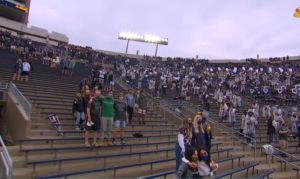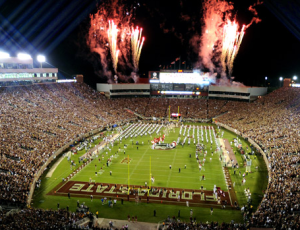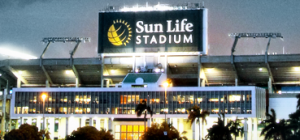Well, the first “real” weekend of limited-audience experiments in college and pro football is now in the books, and from a fan-compliance standpoint, it is still very much a work in progress. While Mobile Sports Report wasn’t able to be at any of the games live, we did try to keep a finger on the pulse of what was happening via news reports and Twitter posts, the latter of course are always subject to the caveat that sometimes we simply can’t verify the validity of the posts.
But from corroborations on social media and from news reports, it was pretty obvious that at certain venues — especially Florida State and Oklahoma — fans, especially college students, were simply not adhering to the Covid-19 precautions put in place by the venues that were allowing fans to attend.
“Masks are required.”
About that, @floridastate… pic.twitter.com/nfha5Khyb1
— Travis Akers (@travisakers) September 12, 2020
Since the Florida State game (a 16-13 loss to Georgia Tech) was on national TV on ABC, it was pretty easy for anyone to see that many in the limited-attendance crowd were not paying any attention to rules about masks and social distancing. The Tallahassee Democrat ran a story about the national reaction to the fans, and got this quote from FSU athletic director David Coburn:
“We were disappointed with some fans, particularly some student fans, at the Georgia Tech football game who did not comply with our policies regarding social distancing and wearing masks while in their seats,” FSU Athletic Director David Coburn said Sunday in a statement to the Democrat. “There was ample room for all fans to remain safely distanced. We have three weeks until our next home game, and we will re-double our efforts to both inform our patrons and improve compliance with the new rules.”
Florida State students are a whole other breed when it comes to actually using common sense. Do they even know what social distancing is? Or masks in this situation? pic.twitter.com/NR7JHddjp4
— Matthew Gold (@matthewgold2000) September 12, 2020
The bigger question that goes unanswered, of course, is why there was no attempt to enforce the Covid-19 rules.
Some similar behavior was on display at Oklahoma, where students also seemed to ignore Covid-19 precautions once inside the stadium. A story in the OU Daily has a photograph showing students massing close together, with minimal mask wearing. Though OU had protocols in place — like distance markers at concession stands — an attendee at the game noted that while “many followed the protocols a significant number [of fans] did not.”
Notre Dame, on the other hand, seemed to have a better amount of buy-in from students on Covid-19 safety procedures. From what we could tell by watching the NBC broadcast of the Irish’s win over Duke, students (and the band) seemed to be complying well with social distancing in the stands and the wearing of masks.Were the pro games better?
Two of the NFL games this weekend, including the Thursday night season opener in Kansas City, also allowed a limited number of fans, and as far as we can tell (from tracking Twitter and news reports) fans at those games largely followed the extensive procedures put in place ahead of the games. The Jacksonville Jaguars, who beat the Indianapolis Colts 27-20 in their home opener, had a full web page that described what fans needed to do to help keep everyone safe. With no reports of bad fan behavior in Jacksonville we are assuming most of the fans in attendance complied with the rules.
And while fans at the Kansas City Chiefs’ home opener may have earned some national derision for booing the players’ pregame solidarity moment, from what we could tell it looked like fans in the seats were staying apart and masked. Thanks to the Twitter feed of Tom Proebstle for his posts from Arrowhead.
Our new world order (temporarily) in the stands at Arrowhead #sportsbiz #stadia pic.twitter.com/1HTqpDGNzB
— Tom Proebstle (@tomproebstle) September 11, 2020
So far normal at concessions other than the dots at Arrowhead #sportsbiz #stadia pic.twitter.com/APv0SOtBgu
— Tom Proebstle (@tomproebstle) September 11, 2020
In seats at Arrowhead, staff are reminding you to wear your mask #sportsbiz #stadia #foggyglasses pic.twitter.com/1RZdpVVrLd
— Tom Proebstle (@tomproebstle) September 10, 2020
Not sure how this will hold up in the restrooms at Arrowhead #Stadia #sportsbiz pic.twitter.com/ap27IaT6Xf
— Tom Proebstle (@tomproebstle) September 11, 2020









